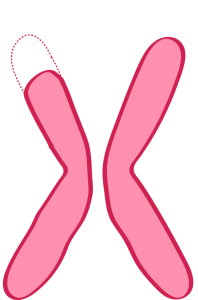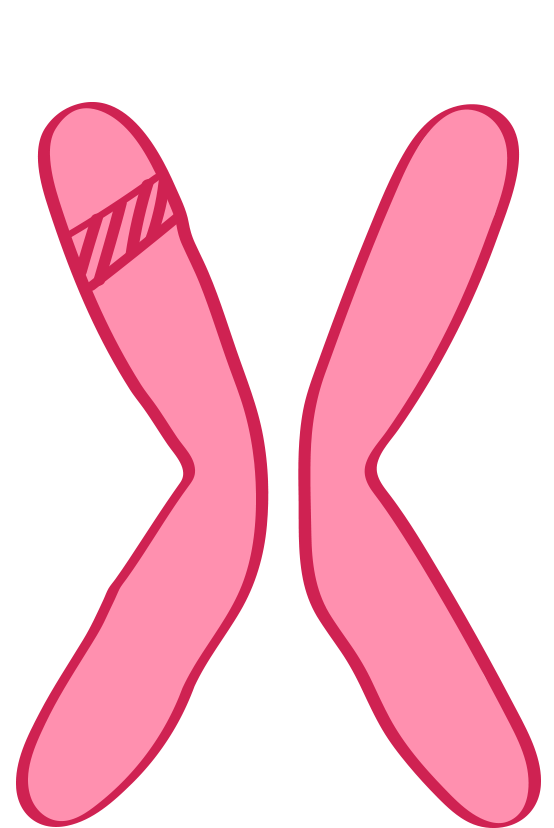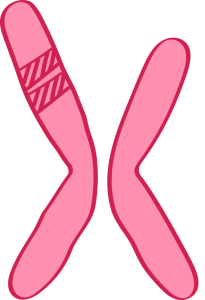A chromosome that is missing a part is called a “deletion” and a chromosome that is partially increased is called a “duplication”.
Tokyo Clinical Laboratory’s next-generation sequencers report test results when there are deletions or duplications of 7 million bases (7 Mb)
or more.
Microdeletion diseases can be manifested by deletions of as little as 1 to 3 million nucleotides, but some cases can involve more than 7 million nucleotides, including the gene in question. Large deletions beyond the disease-specific gene deletion may be associated with similar symptoms or more severe disease because the gene is defective. Therefore, we believe it is appropriate to give the same diagnostic name to a disease-specific deletion, even if it is large in extent, if it is included in the disease-specific region. Because the term “microdeletion” is misleading, we refer to it as “partial deletion disease” on this site.
-

All autosomal regions
Partial Deletion syndrome
-

Normal
-

All autosomal regions
Partial Duplication syndrome
Deletions and duplications can have a variety of symptoms depending on the function of the gene present in the area. For example, if a chromosome containing a gene that produces a certain type of enzyme is deleted, an enzyme deficiency is seen; if a chromosome containing a gene responsible for bone formation is duplicated, an abnormality of bone formation is seen.
Chromosome deletions and duplications were conventionally detected under a microscope by staining chromosomes with horizontal stripes, but this method could only detect deletions and duplications of approximately 10 million bases (10 Mb) or more. In recent years, more accurate testing has become possible with the use of next-generation sequencers and microarray chromosome testing. As a result, deletions and duplications do not occur only in specific chromosomes, but are found throughout the entire chromosome, and the symptoms of each site of abnormality are now known. The association between deletions and duplications and the accompanying clinical findings has been reported, and a database of genetic information on the abnormalities has been compiled. Some of these cases have been reported based on common abnormal regions and characteristic findings, and some have been placed as independent diseases, while others are rare or have never been reported before. Therefore, when a deletion or duplication is found that has not been reported to be associated with an independent disease, it is necessary to search case reports and genome databases for the individual symptoms that appear.
Cases with a 14.4 million base duplication of chromosome 7 have been reported to show abnormalities in the skeletal system, especially the spine and sacral tailbone, which are related to HLXB9, a homeobox gene involved in body formation. However, not all genes in the duplicated regions have been found to be associated with clinical findings. In some cases, deletions or duplications are found but do not cause any symptoms. This is the case when the deletion or duplication does not contain an important gene involved in vital functions or body formation, or when the gene is present but of a type that does not cause pathological findings. One such example is a duplication on the short arm of chromosome 8 (8p23.2) that spans 2.5 million bases (2.5 Mb) but is understood to be a normal mutation with no abnormal findings because only one tumor suppressor gene is located there. However, it is necessary to distinguish whether a deletion or a duplication is pathological or not, but it is impossible to make such a judgment if it has never been reported before. We hope you understand that we are unable to make such a diagnosis for those cases that have not been reported so far.
Nameless Cases
These are examples of case reports of recently reported cases of all autosomal whole region part deletion and duplication diseases.
| Chromosome | Chromosome location | Article |
|---|---|---|
| 2 | 2p16.3-p21 | Contiguous gene deletion of chromosome 2p16.3-p21 as a cause of Lynch syndrome(Back Translation) |
| 7 | 7q21.3-q31.1 | Pure Interstitial 7q21.3-q 31.1 Duplication: A Rare Segmental Genomic Aneuploidy: Case Report and Review of Cases with Distal and Similar Segment Involved (Back Translation) |
| 12 | 12q24.31-q24.33 | Autism associated with partial deletion of chromosome 12 (12q24.31-q24.33): an additional report of a very rare disorder (Back Translation) |
| 14 | 14q | Partial duplication of chromosome 14 (Back Translation) |
| 19 | 19p13.13 | Novel microdeletion/microduplication syndrome of chromosome 19 (19p13.13) (Back Translation) |
Reported Cases of Partial Deletion / Duplication
of all Autosomal Chromosomes
Chromosome Deletion
| Chromosome | Deleted Portion | Syndrome | Remarks |
|---|---|---|---|
| 1 | 1p12 | Alagille syndrome | |
| 1 | 1q21.1 | 1q21.1 microdeletion syndrome | |
| 1 | 1p36 | 1p36 deletion syndrome | Frequency of occurrence (at birth) 1 out of 4,000 to 10,000 cases. Growth difficulties, severe mental retardation, intractable epilepsy, and other conditions. |
| 2 | 2q13 | Nephronophthisis Type 1 | |
| 2 | 2p21 | Total anterior encephalocele | |
| 2 | 2q37.3 | Albright’s syndrome-like metacarpal and metatarsal shortening | |
| 3 | 3q29 | 3q29 microdeletion syndrome | |
| 4 | 4p16.3 | Wolf-Hirschhorn syndrome | Frequency of occurrence (at birth) 1 out of 50,000 cases. Severe mental developmental delay, growth problems, intractable epilepsy, multiple morphological abnormalities. |
| 5 | 5p13.2 | Cornelia de Lange syndrome | |
| 5 | 5p15.2 | Cri-du-chat Syndrome | Frequency of occurrence (at birth) 1 out of 20,000-50,000 cases Low birth weight, growth problems, high-pitched cat-like cries. Small head size, decreased muscle tone, and psychomotor development. Chromosome 5 partial deletion: high-resolution mapping in cri-du-chat syndrome |
| 5 | 5q35.3 | Sotos syndrome | Some differences in symptoms between the deletion and duplication types have been reported. Frequency of occurrence (at birth) 1 of 14,000 cases. |
| 7 | 7q11.23 | Williams syndrome | |
| 7 | 7p13 | Pallister-Hall syndrome | |
| 7 | 7p14.1 | Greig Cephalopolysyndactyly Syndrome | |
| 7 | 7p21.1 | Saethre-Chotzen syndrome | |
| 7 | 7q36.3 | Total Anterior Encephalocele Type 3 | |
| 8 | 8q12.2 | CHARGE syndrome | |
| 8 | 8p23.1 | 8p23.1 microdeletion syndrome | |
| 8 | 8q23.3 | Trichorhinophalangeal Syndrome Type 1 | |
| 8番 | 8q24.11 | Langer-Giedion syndrome | |
| 11 | 11p11.2 | Potocki-Shaffer syndrome | |
| 11番 | 11p13 | WAGR syndrome | |
| 12 | 12q24.13 | Noonan syndrome | 1 case of duplication and 1 case of deletion reported in RAF1 |
| 13 | 13q14.2 | Retinoblastoma, developmental delay | |
| 13 | 13q32.3 | Total anterior encephalocele type 5 | |
| 15 | 15q11.2〜q13 | Prader-Willi syndrome | Deletion of a gene of paternal origin, attributed to a gene of maternal origin Frequency of occurrence (at birth) 1 out of 10,000-25,000 cases Hypomuscularity, hypopigmentation, hypoplasia of external genitalia |
| 15 | 15q11.2〜q13 | Angelman syndrome | Occurs due to loss of function of UBE3A Frequency of occurrence (at birth) 1 out of 12,000 cases. Severe mental developmental delay, epilepsy, ataxic movement disorder, behavioral abnormalities, sleep disturbances, hypochromia, and characteristic facial features. |
| 16 | 16p11.2 | 16p11.2 microdeletion | |
| 16 | 16p13.11 | 16p13.1 microdeletion | |
| 16 | 16p13.3 | Rubinstein-Taybi syndrome | Frequency of occurrence (at birth) 1 out of 125,000 |
| 17 | 17p13.3 | Miller-Dieker syndrome | |
| 17 | 17p11.2 | Smith-Magenis syndrome | Frequency of birth (at birth) 1 out of 15,000~25,000 cases |
| 17 | 17q11.2 | Neuroblastoma Type 1 | |
| 20 | 20p12.23 | Alagille syndrome | |
| 22 | 22q11.2 | DiGeorge syndrome Type 2 22q11.2 deletion syndrome |
Frequency of occurrence (at birth) 1 out of 4,000 cases Congenital heart disease, delayed mental development, distinctive facial features, immunocompromised, cleft palate/soft palate closure, nasal voice, hypocalcemia. |
| 22 | 22q13.33 | Phelan-McDermid syndrome |
Chromosome Duplication
| Chromosome | Duplicated Portion | Syndrome | Remarks |
|---|---|---|---|
| 1 | 1q21.1 | 1q21.1 microduplication syndrome | 1q21.1 Partial duplication(Back translation) |
| 2 | 2p21 | Total anterior encephalocele | |
| 3 | 3q29 | 3q29 microduplication syndrome | |
| 5 | 5p13.2 | Cornelia de Lange syndrome | |
| 5 | 5q35.3 | Sotos syndrome | Some differences in symptoms between the deletion and duplication types have been observed. |
| 8 | 8p23.1 | 8p23.1 microduplication syndrome | |
| 9 | 9q34.13 | Tuberous sclerosis type 1 | Caused by the TSC1 gene. 1 out of 5,800 cases. |
| 10 | 10q24.3 | 10q24 duplication syndrome | |
| 11 | 11p11.2 | Potocki-Shaffer syndrome | |
| 11 | 11p13 | WAGR syndrome | |
| 12 | 12q24.1 | Noonan syndrome | 1 case of duplication and 1 case of deletion reported in RAF1 |
| 13 | 13q32.3 | Total anterior encephalocele type 5 | |
| 15 | 15q11.2〜q13 | Prader-Willi syndrome | Deletion of a gene of paternal origin, attributed to a gene of maternal origin. Incidence (at birth) 1 out of 10,000-25,000 cases. Hypomuscularity, hypopigmentation, hypoplasia of external genitalia. |
| 15 | 15q11.2〜q13 | Angelman syndrome | Occurs due to loss of function of UBE3A Frequency of occurrence (at birth) 1 out of 12,000 cases. Severe mental developmental delay, epilepsy, ataxic movement disorder, behavioral abnormalities, sleep disturbances, hypochromia, and distinctive facial features. |
| 15 | 15q26qter | Overgrowth and intellectual disability | |
| 16 | 16p11.2 | 16p11.2 microduplication | |
| 16 | 16p13.3 | Tuberous sclerosis type 2 | Caused by the TSC2 gene. 1 out of 5,800 cases. |
| 16 | 16p13.3 | Rubinstein-Taybi syndrome | Caused by the CREBBP gene. Frequency of occurrence (at birth) 1 out of 125,000 cases |
| 16 | 16p13.11 | 16p13.1 microduplication | |
| 17 | 17p11.2 | Potocki-Lupski syndrome | Chromosome 17 (17p11.2) partial duplication: Duplication in children with developmental delay |
| 17 | 17p12 | Charcot-Marie-Tooth disease, type 1A | |
| 17 | 17q21.31b | 17q21.31 microduplication syndrome | |
| 22 | 22q11.1 | Cat’s eye syndrome | |
| 22 | 22q11.2 | 22q11.2 Duplication syndrome | Congenital heart disease, delayed mental development, distinctive facial features, immunocompromised, cleft palate/soft palate closure, nasal voice, hypocalcemia. |
(Reported examples are part of partial deletion / duplication)
The next-generation sequencer used at the Tokyo Clinical Laboratory cannot detect deletions or duplications of 7 million bases or less.
Not all cases of the syndrome can be detected.


